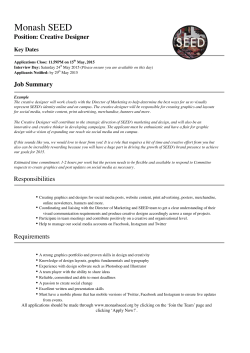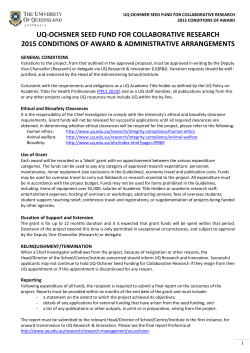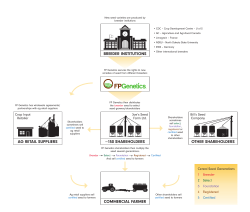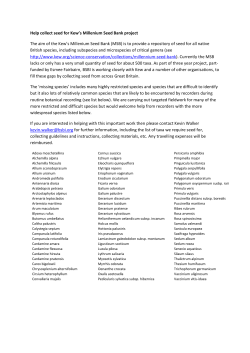
Bend Seed Extractory - 2015 National Native Seed Conference
NATIVE SEED PROCESSING Kayla Herriman, Manager Sarah Garvin, Assistant Manager Is seed cleaning necessary? • Challenges • Availability • Time • Cost • Coordination • Benefits • Known viability • Known purity • Provides options for sowing • Storage potential What does the extractory provide? • Extracts, cleans and stores seed • Any governmental agency • (USFS, BLM, USFWS, NPS, Fed. Hwy., BIA, Tribes) • Over 2,800 native plant species • Provides granary & freezer storage • Arranges for testing & shipping • Maintains seed inventory database • Information hub Achnatherum occidentale western needlegrass Elymus elymoides bottlebrush squirreltail How is seed processed? Machines: • Screens • Air • Motion Seed separation • Machines exploit the difference in physical properties of target seed and non-target material. What does processing look like? Raw Material Seed with Inert and Non-target Material Pure Seed Seed with Inert Material What testing is standard? Seed Weight • • • Seed weight can indicate seed size, density Depending on the variety, production site, and rainfall during the growing season, there can be significant differences in the number of seeds per pound Helps in determining the seeding rate Purity Test • • This test determines the percentage by weight of pure seed, other crop seeds, and inert matter Certified purities are available What testing is standard? Seed Moisture • Measured using percent equilibrium relative humidity Seed X-ray • A test to reveal the internal tissue • • Abnormalities, empty seeds, absence of embryos, mechanical and internal damages, and insect infestation Non-destructive How is seed packaged? What are storage options? Services vary by facility • Freezer storage • BSE stores at 15°F • Granary storage • BSE stores at 55°F • Cold storage • BSE stores at 34°F SOS: Successes and Challenges Penstemon fruticiformis Penstemon palmereii Sporobolus cryptandrus Eriogonum heradeoides Rhus ovata Sporobolus wrightii Eriogonum nudum Rhus tribbata Sporobolus flexuosus Rhus aromatica Penstemon strictus Eriogonum ovalifolium What information do we have? • BSE has records associated with every collection • Incoming weight • Processing notes • Machines used and settings • Time spent • Final weight • In-house testing • Certified testing results • Final processing reports How can data help? Atriplex canescens (ATCA2) • 10,000 pure live seed (PLS) are required for long-term storage • 5,000 PLS are needed for nursery grow out. Average yield data show that approx 7,700 PLS/lb of raw wt. can be expected for ATCA2, so… 15,000 PLS/7,700pls/lb = 1.94 lbs raw material needed * Average PLS/lb of raw wt. was used in this calculation instead of yield (%) or seeds/lb because ATCA2 typically finishes with a lower than desired percent purity and/or percent fill due to limitations in the extraction process. This is typical of many Atriplex species, conifers, and species producing fleshy fruit. If unsure, make calculations using all methods and take the highest number for field collection. Kate Pavich, an SCA Team Member with the BLM Bishop Field Office (California) collecting seed at the Volcanic Tablelands. Photo by Student Conservation Association Aristida purpurea Hesperostipa comata Atriplex canescens Ambrosia dumosa Acourtia wrightii Machaeranthera pinnatifida Kayla Herriman 541.383.5481 kherriman@fs.fed.us Sarah Garvin 541.383.5646 sarahegarvin@fs.fed.us Bend Seed Extractory 63095 Deschutes Market Road Bend, Oregon 97701 The preceding presentation was delivered at the 2015 National Native Seed Conference Santa Fe, New Mexico April 13-16, 2015 This and additional presentations available at http://nativeseed.info
© Copyright 2025









